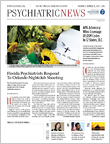The opportunity to learn about more efficacious ways to treat children and adolescents with attention-deficit/hyperactivity disorder (ADHD) and a new outlook on ADHD among adults drew attendees to a session at APA’s 2016 Annual Meeting in Atlanta in May.
A number of controversies attend any discussion of ADHD in young people, said David Coghill, M.D., a professor of child and adolescent psychiatry at the University of Melbourne, Australia. A lack of special biomarkers and objective tests has been compounded by arbitrary cutoffs and use of personal judgment to arrive at a diagnosis, he said. In addition, diagnostic criteria have broadened over time, and there is much geographic variation in diagnosis and use of medications.
Prevalence worldwide appears to be about 5 percent, but rates of diagnosis have changed since the 1970s. In some U.S. states, for instance, rates are as high as 11 percent, and there are significant variations within some states as well. In Scotland, where Coghill was formerly on the faculty of the University of Dundee, there are 10-fold differences in the rates of diagnosis across that small country’s 13 regions.
“There is thus likely much over- and undertreatment,” he said. In Australia, a major problem is getting primary care doctors to believe parents, leading to underdiagnosis. Conversely, a study he co-led in China initially found a 17 percent level of false positives, but when investigators trained teachers to do an initial screening, the false-positive rate fell to 2.9 percent and specificity rose to 97 percent.
Another problem for both diagnosis and treatment lies in the proliferation of ADHD guidelines worldwide. They are not consistent, are not evidence based, are vaguely or densely written, and pay little attention to monitoring, he said. Those drawbacks mean that clinicians are less likely to use them.
Coghill suggested use of the Dundee ADHD Clinical Care Pathway (DACCP), which “uses standard protocols for the assessment, titration, and routine monitoring of clinical care and treatment outcomes.”
The program begins with a four-week titration period focused on symptom reduction by seeking “maximum benefit at minimum dose,” delivered by nurses with physician backup. The key, though, is “rigorous outcome measurement for continuing care,” he said. “Act on what we find as we monitor symptoms.”
As for adults, new evidence—still awaiting replication—suggests that adult-onset ADHD may be a different phenomenon from its childhood analogue, said Philip Asherson, Ph.D., a professor of molecular psychiatry at King’s College London.
By age 25, 15 percent of children with diagnosed ADHD still meet the full diagnostic criteria, but 65 percent have subdiagnostic impairing symptoms, said Asherson.
The Dunedin study by Terrie Moffitt, Ph.D., and colleagues (reported in the October 2015
American Journal of Psychiatry) concluded that only 5 percent of childhood-onset ADHD patients met adult ADHD criteria at age 38, while only 10 percent of adult ADHD patients had met childhood ADHD criteria at ages 11 to 13 (
Psychiatric News, July 3, 2015).
“Unexpectedly, the childhood ADHD and adult ADHD groups comprised virtually nonoverlapping sets; 90 percent of adult ADHD cases lacked a history of childhood ADHD,” the authors wrote. “Also unexpectedly, the adult ADHD group did not show tested neuropsychological deficits in childhood or adulthood, nor did they show polygenic risk for childhood ADHD.”
“We know little about this group,” said Asherson. “Many had problems but had not been diagnosed with ADHD.”
Common adult symptoms included emotional instability, restlessness, low self-esteem, poor concentration, distractibility, impulsivity, and “mind wandering and ceaseless mental activity.”
This last characteristic is a key point for Asherson. Mind wandering correlates with ADHD symptoms and predicts both ADHD impairments and diagnosis.
“Mind wandering involves ordinary, internally generated thoughts, but they are undercontrolled,” he said. “The mind constantly jumps from one topic to another, and there are multiple lines of thought at the same time.”
A likely explanation is that such thoughts are generated in the default-mode network, the brain activity that takes place when the individual is at rest and not engaged in some mental task—rather like a car that is idling at a stoplight.
“Ordinarily, when the mind is engaged in a task, activity increases in the task-positive network and decreases in the default-mode network,” said Asherson. “But adults with ADHD don’t tune out the default-mode network, so it’s harder to focus, and they don’t engage as well in the task.”
A pharmacological challenge with stimulant medications can help determine whether changes in brain function can lead to changes in symptoms, he said.
“We conclude that ADHD should be recognized in the same way as other common adult mental health disorders, and that failure to recognize and treat ADHD is detrimental to the well-being of many patients seeking help for common mental health problems,” wrote Asherson and three colleagues in an extended discussion of the same topic in the June issue of The Lancet. ■
“Effective Management of Attention-Deficit/Hyperactivity Disorder (ADHD) Through Structured Re-Assessment: the Dundee ADHD Clinical Care Pathway” can be accessed
here. An abstract of “Adult Attention-Deficit Hyperactivity Disorder: Key Conceptual Issues” is available
here.
